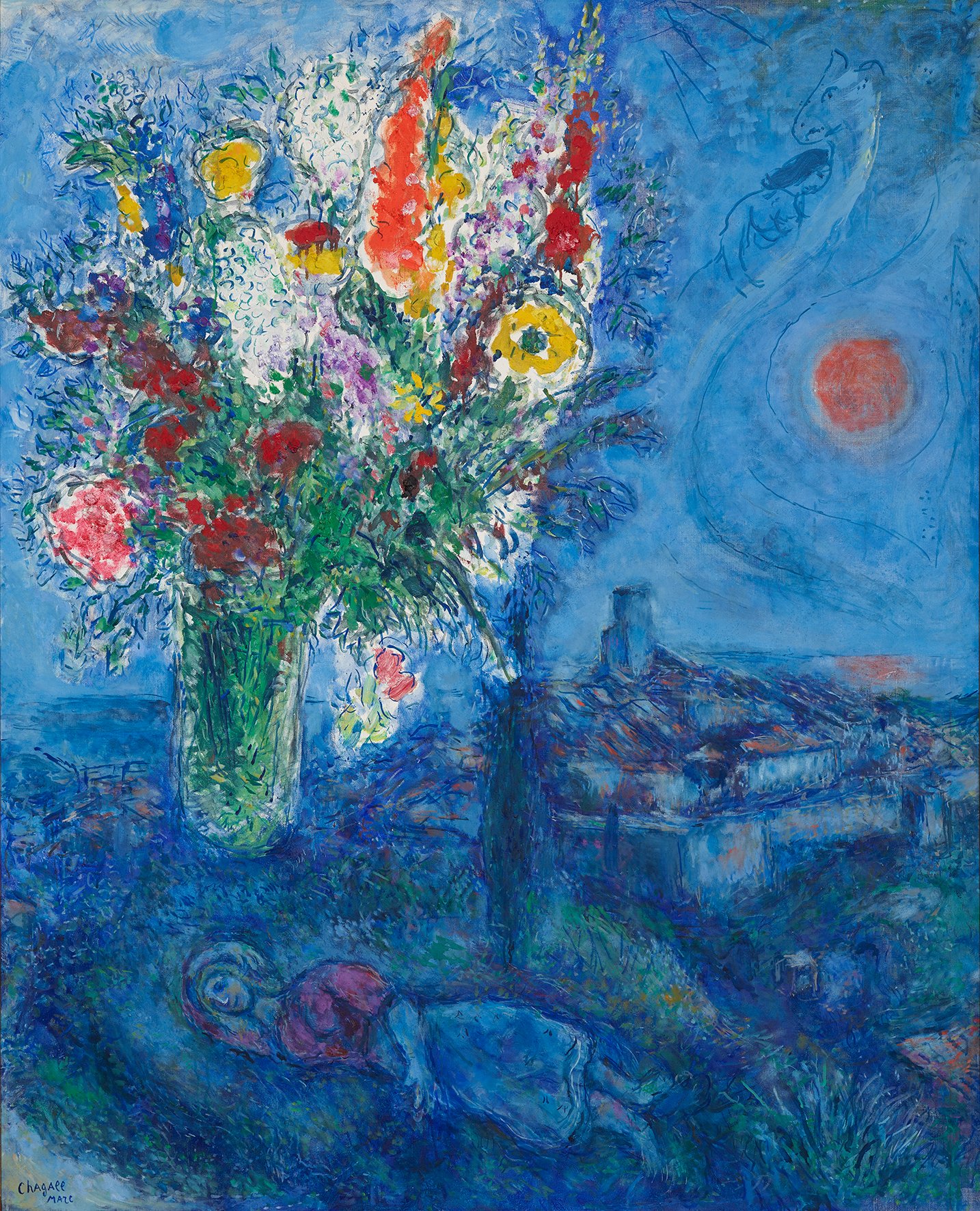
The Albertina Museum in Vienna has opened a major retrospective of Marc Chagall (1887–1985), commemorating 40 years since the artist’s death. Running until February 9, 2025, the show brings together over 100 works made over the course of his life. Born in the shtetl of Vitebsk, Chagall’s childhood memories, themes of nostalgia, longing, and Jewish identity recur throughout his oeuvre.
While Chagall’s works are often filled with harmonious colors, from celestial blues to vibrant reds, the paintings seem joyous and ethereal at first glance, but there are also many darker themes that permeate the work. Displacement was a central theme to his life and work: having lived through pogroms, two world wars, and the persecution of Jews during the Nazi regime, Chagall was forced into exile multiple times. Yet, even in exile, he never lost his connection to his homeland and memories of Vitebsk, a small town in what is now Belarus, then part of the Russian Empire. He migrated from Russia to Paris to study at the Ecole de Paris, before moving to New York, and eventually back to France.
Marc Chagall, Rabbi in Black and White (The Praying Jew) (1914-22). Fondazione Musei Civici di Venezia, Galleria Internazionale d′Arte Moderna di Ca’ Pesaro © Bildrecht, Vienna 2024.
The exhibition at the Albertina allows visitors to experience Chagall’s use of symbolism. His paintings are filled with floating lovers, violin-playing rabbis, roosters, cows, headless figures and biblical motifs, often with a heightened perspective, drawing the viewer’s into the visually stimulating scenes. These recurring motifs, often fantastical, mirror his own life experiences, blending happiness and joy with suffering, displacement and a deep connection to his Jewish heritage. He was deeply inspired by the Bible, considering it “the greatest source of poetry of all time.” He produced many artworks based on Biblical stories, including a famous series of Bible illustrations and stained glass windows for churches, synagogues, windows for the Hadassah Hospital in Jerusalem, the UN building in New York, and the Notre Dame Cathedral in Reims, France.
Marc Chagall, Birthday [detail] (1923). AOKI Holdings
© Bildrecht, Vienna 2024 / Photo: AOKI Holdings.
Marc Chagall, The Blue Circus (1950–1952). Centre Pompidou, Paris, Musée national d’art moderne – Centre de création industrielle, dation en 1988, en dépôt au Musée national Marc Chagall, Nice © Bildrecht, Vienna 2024.
The Albertina’s retrospective celebrates Chagall’s artistic achievements and reflects his impact on modern art. Refusing to conform to the avant-garde movements of his time, Chagall developed a deeply personal style that was rooted in his cultural and spiritual background. His contemporaries spanned different movements—from Symbolism, Surrealism, Expressionism, and the broader avant-garde. He developed his style in conversation with but often apart from, many artists including Picasso, Modigliani and Kandinsky. His ability to unite opposites—joy and sorrow, memory and imagination—gave his work a quality that continues to inspire generations of artists, musicians, writers and poets.
Marc Chagall, To Russia, Asses and Others (1911). Centre Pompidou, Paris, Musée national d’art moderne– Centre de création industrielle, don de l’artiste en 1953. © Bildrecht, Vienna 2024.
As the final exhibition under Klaus Albrecht Schröder’s leadership, the Chagall retrospective closes an important chapter for the Albertina Museum. In collaboration with the Kunstsammlung Nordrhein-Westfalen in Düsseldorf, the exhibition offers a comprehensive retrospective on Chagall’s artistic legacy.
Marc Chagall, The Great Circus (1970). The ALBERTINA Museum, Vienna – The Batliner Collection. © Bildrecht, Vienna 2024.
Visitors will leave with a deeply comprehensive understanding of his work and a renewed appreciation for how he captured the complexities of human life and emotion—joy, sorrow, love, and loss—through a visual language that continues to move many audiences across the world.